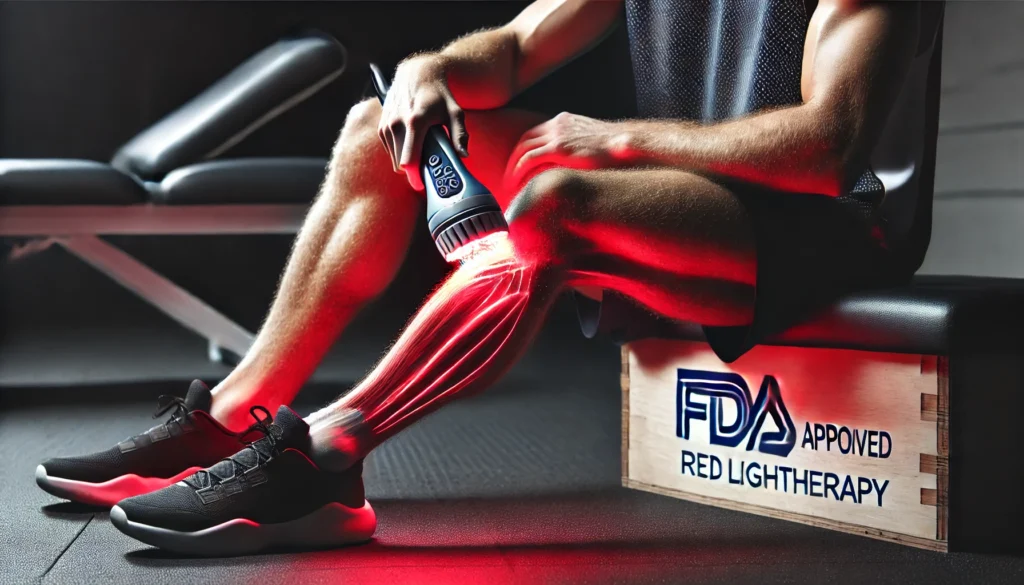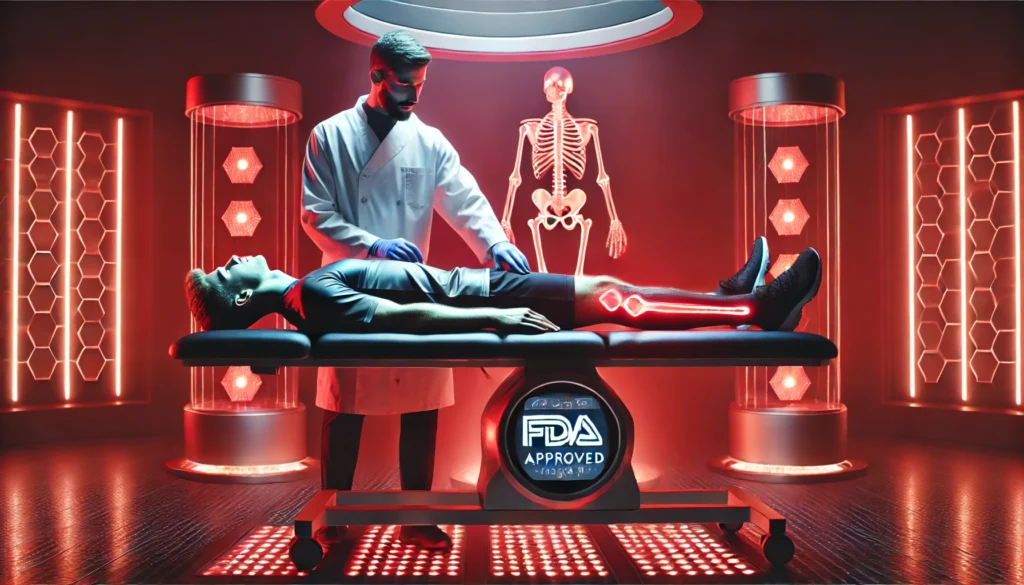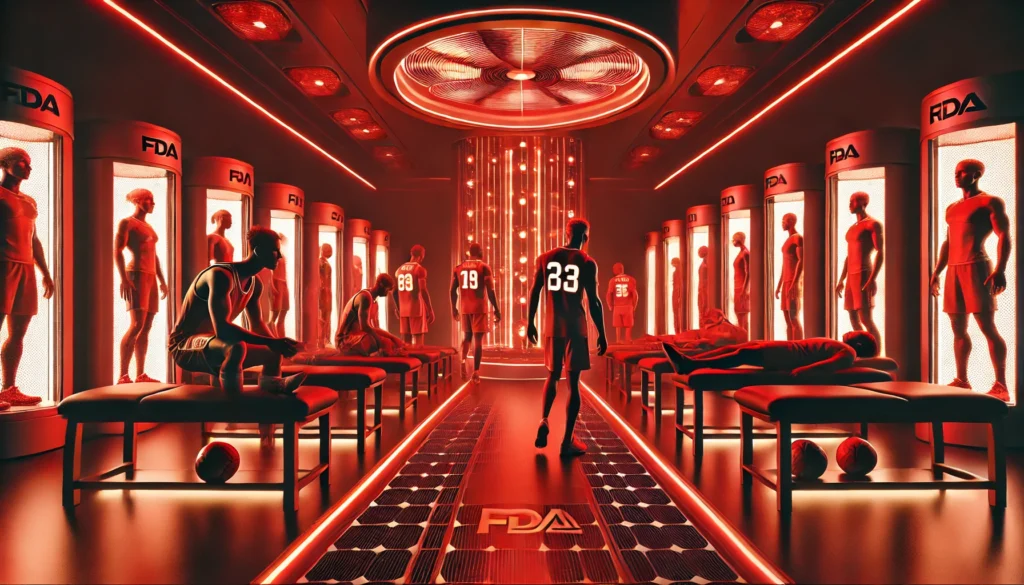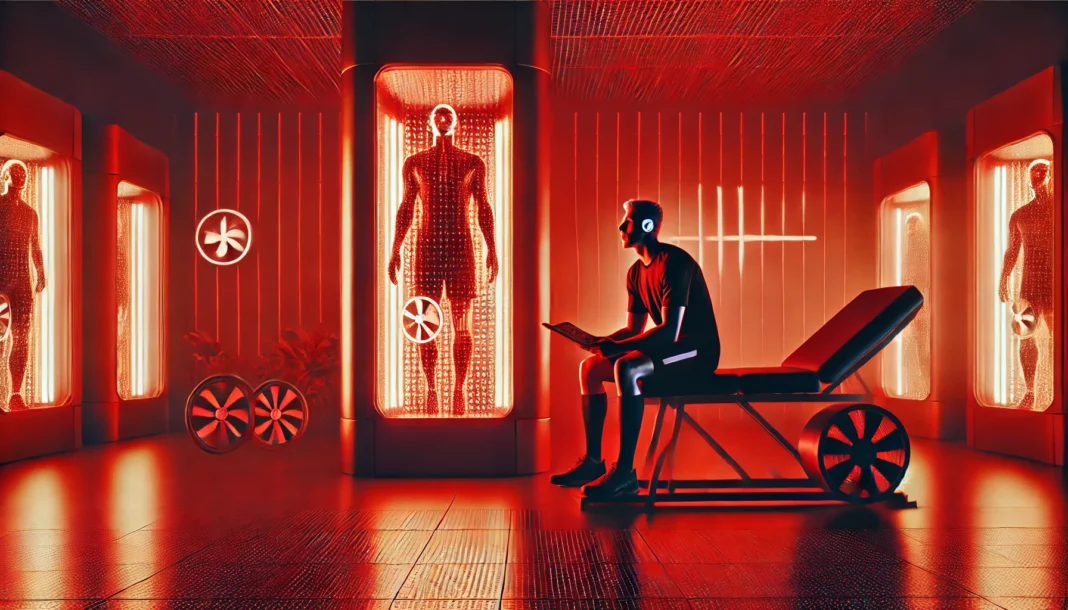Introduction: The Science Behind Athletic Recovery and Red Light Therapy
Athletes at all levels push their bodies to the limit, striving for peak performance while managing the inevitable stress and strain that come with rigorous training. Recovery is a crucial component of athletic success, allowing the body to heal, adapt, and improve. One of the most exciting advancements in this space is red light therapy, a non-invasive treatment that has gained considerable attention for its ability to enhance recovery and reduce pain. Among the various red light therapy options available, FDA approved red light therapy devices for pain stand out as a gold standard, ensuring safety, efficacy, and reliability.
You may also like: Red Light Therapy for Muscle Recovery: How Athletes Can Speed Healing and Enhance Performance
Red light therapy harnesses the power of low-level wavelengths of red and near-infrared light to penetrate the skin and stimulate cellular processes. Research has demonstrated its potential to accelerate tissue repair, reduce inflammation, and alleviate pain, making it an invaluable tool for athletes looking to optimize their recovery strategies. FDA approved red light therapy devices have undergone rigorous testing to confirm their benefits, providing athletes with a science-backed solution for managing pain and enhancing performance.
This article explores the role of FDA approved red light therapy devices for pain in athletic recovery, breaking down the science, benefits, practical applications, and expert insights to help athletes maximize their performance and well-being.
Understanding Red Light Therapy: How It Works
Red light therapy, also known as low-level laser therapy (LLLT) or photobiomodulation (PBM), works by delivering specific wavelengths of light to the skin and underlying tissues. Unlike ultraviolet (UV) light, which can damage cells, red and near-infrared light stimulate mitochondria—the powerhouse of the cell—boosting energy production and enhancing cellular repair processes.
The mitochondria play a crucial role in converting nutrients into adenosine triphosphate (ATP), the energy currency of the cell. When cells absorb red and near-infrared light, ATP production increases, leading to improved cellular function, reduced oxidative stress, and enhanced healing. This process is particularly beneficial for athletes dealing with muscle fatigue, micro-tears, and inflammation following intense physical exertion.
Studies have shown that FDA cleared red light therapy can also enhance blood flow, delivering essential nutrients and oxygen to tissues while removing metabolic waste products. By promoting circulation, red light therapy aids in the reduction of muscle soreness and accelerates the recovery process, making it a game-changer for athletes who train rigorously.
The Benefits of FDA Approved Red Light Therapy Devices for Pain Relief
One of the primary reasons athletes turn to FDA approved red light therapy devices for pain is their ability to alleviate discomfort without the need for pharmaceuticals or invasive procedures. Pain is a common challenge in sports, often stemming from overuse, muscle strain, or injury. Traditional pain management strategies, such as nonsteroidal anti-inflammatory drugs (NSAIDs) or opioids, come with potential side effects and risks. Red light therapy offers a natural, side-effect-free alternative that addresses pain at its source rather than simply masking symptoms.
1. Reduction of Inflammation and Swelling
Inflammation is a natural response to exercise-induced stress, but excessive inflammation can impede recovery and lead to prolonged discomfort. FDA approved red light therapy has been shown to modulate inflammatory pathways, reducing the production of pro-inflammatory cytokines while enhancing anti-inflammatory responses. This helps mitigate swelling and speeds up healing, allowing athletes to return to training faster and with less discomfort.
2. Enhanced Muscle Recovery and Performance
For athletes, muscle recovery is a top priority. Red light therapy accelerates muscle repair by increasing mitochondrial efficiency and ATP production. This leads to faster recovery from workouts, reduced muscle fatigue, and improved endurance. Studies suggest that athletes who incorporate FDA cleared red light therapy into their routine experience enhanced muscle strength and performance over time.
3. Pain Relief Without Medication
Chronic pain conditions, such as tendinitis, arthritis, and delayed onset muscle soreness (DOMS), can significantly hinder an athlete’s ability to perform. FDA red light therapy targets pain receptors, reducing discomfort and improving mobility without the need for medication. This makes it an appealing option for athletes seeking long-term pain relief without dependency on drugs.
Choosing the Right FDA Approved Red Light Therapy Devices
With a growing number of red light therapy devices on the market, selecting an FDA approved red light therapy device ensures both safety and effectiveness. The FDA approval process involves rigorous testing for safety, quality, and efficacy, meaning athletes can trust these devices to deliver scientifically validated benefits.
When choosing a red light therapy device, consider the following factors:
1. Wavelength and Power Output
Optimal therapeutic effects occur within the red (630-660 nm) and near-infrared (810-850 nm) wavelength ranges. Devices within these ranges penetrate deeply into tissues, providing maximum benefits for muscle recovery and pain relief.
2. Treatment Area and Coverage
Some devices are designed for localized treatment (e.g., FDA approved red light therapy devices for face), while others offer full-body coverage. Athletes should choose devices that align with their specific recovery needs, whether targeting a sore knee or an entire muscle group.
3. Portability and Convenience
Portable devices offer flexibility for athletes who travel frequently, ensuring they can maintain their recovery routine on the go. Handheld and wearable red light therapy devices provide targeted treatment with ease of use.

Integrating Red Light Therapy into an Athletic Recovery Routine
To maximize the benefits of FDA cleared red light therapy, athletes should incorporate it strategically into their training and recovery regimen. Research suggests that consistency is key, with most protocols recommending daily or near-daily use for optimal results.
1. Pre-Workout Preparation
Using red light therapy before exercise can help prime muscles, enhance blood circulation, and reduce the risk of injury. Pre-workout application has been shown to improve muscle performance and reduce post-exercise soreness.
2. Post-Workout Recovery
Applying red light therapy after training aids in muscle repair, reduces inflammation, and accelerates recovery. Many athletes find that post-workout sessions enhance their ability to train harder with fewer setbacks.
3. Injury Rehabilitation
For athletes recovering from injuries, FDA approved red light therapy devices offer a non-invasive way to speed up healing. By promoting tissue regeneration and reducing pain, these devices complement physical therapy and rehabilitation programs.
Frequently Asked Questions (FAQ) on FDA Approved Red Light Therapy Devices for Pain
1. How does red light therapy differ from other pain management methods? Red light therapy offers a non-invasive alternative to traditional pain management approaches such as medication, physical therapy, or invasive procedures. Unlike NSAIDs or opioids, which only mask pain symptoms, FDA approved red light therapy devices for pain work at the cellular level to accelerate healing and reduce inflammation. The deep penetration of red and near-infrared light stimulates mitochondrial activity, promoting tissue regeneration without any harmful side effects. Furthermore, FDA approved red light therapy devices are particularly beneficial for athletes who need consistent recovery without the risks associated with prolonged medication use. Over time, using red light therapy consistently can help break the cycle of chronic pain, making it a sustainable long-term solution.
2. What makes an FDA approved red light therapy device more reliable than non-approved alternatives? FDA approval ensures that a red light therapy device meets stringent safety and efficacy standards, which is crucial for consumer trust. Many unregulated red light therapy products on the market may not provide the correct wavelengths or power output necessary for therapeutic benefits. FDA approved red light therapy devices have undergone rigorous clinical testing to validate their effectiveness, meaning users can expect measurable results. Additionally, FDA cleared red light therapy products often come with manufacturer-backed guarantees and scientific research supporting their claims. Investing in an FDA approved device ensures that the treatment is not only safe but also optimized for maximum therapeutic impact.
3. Can red light therapy be used in combination with other recovery techniques? Yes, red light therapy is highly complementary to other recovery strategies such as massage therapy, cryotherapy, and physical rehabilitation exercises. When used in conjunction with stretching and mobility drills, FDA cleared red light therapy can enhance flexibility and prevent injury recurrence. Many professional athletes integrate red light therapy with compression therapy and hydration strategies to maximize muscle recovery. Additionally, combining red light therapy with nutritional support—such as adequate protein intake and anti-inflammatory foods—can further amplify the benefits. Since FDA red light therapy is non-invasive and free from side effects, it can seamlessly fit into almost any recovery routine without contraindications.
4. Is red light therapy beneficial for conditions beyond muscle pain? Absolutely. While red light therapy is commonly used for muscle recovery, it also has applications in skin health, joint pain management, and even neurological conditions. FDA approved red light therapy devices for face are particularly effective in reducing fine lines, wrinkles, and signs of aging by stimulating collagen production. Additionally, individuals suffering from conditions like arthritis, fibromyalgia, and even migraines have reported significant relief after incorporating red light therapy into their routine. Emerging research also suggests potential benefits in cognitive function, with some studies investigating its effects on neurodegenerative conditions like Alzheimer’s disease. These diverse applications make red light therapy a versatile wellness tool beyond just pain relief.
5. How soon can results be expected from red light therapy? The timeline for results varies depending on the severity of the condition being treated and the frequency of therapy sessions. Many users experience noticeable pain relief within the first few sessions, especially when using FDA approved red light therapy devices consistently. Chronic conditions such as arthritis or tendonitis may require several weeks of regular use before significant improvements are observed. Unlike pain medications that provide immediate but temporary relief, red light therapy works by enhancing cellular function, leading to long-term benefits. It is recommended to use FDA cleared red light therapy as part of a daily or near-daily routine for optimal results.

6. Are there any risks or side effects associated with red light therapy? One of the major advantages of FDA approved red light therapy devices is their excellent safety profile. Unlike heat-based therapies, which can cause burns or discomfort, red light therapy does not significantly raise skin temperature. Some users may experience mild redness or temporary skin sensitivity, but these effects typically subside quickly. Because FDA cleared red light therapy is non-invasive, there is no risk of dependency or withdrawal effects, unlike with pain medications. However, individuals with light-sensitive conditions or those on photosensitizing medications should consult a healthcare provider before beginning treatment. As with any therapy, using the device according to manufacturer guidelines ensures the best outcomes.
7. How does red light therapy compare to infrared sauna therapy? Although both therapies use light wavelengths to promote healing, they function differently and serve distinct purposes. Infrared saunas primarily use far-infrared heat to raise body temperature, promoting detoxification and relaxation. In contrast, FDA approved red light therapy devices for pain use specific red and near-infrared wavelengths to penetrate deeper into tissues, directly targeting cellular function and reducing inflammation. While infrared saunas can enhance circulation and support muscle relaxation, red light therapy provides more targeted and scientifically validated benefits for pain relief and tissue repair. Many individuals combine both therapies for a comprehensive wellness approach, leveraging the advantages of each.
8. Can red light therapy improve athletic performance, or is it only for recovery? Beyond recovery, red light therapy has been shown to enhance athletic performance by increasing muscle endurance and reducing fatigue. Studies indicate that pre-workout exposure to FDA cleared red light therapy can improve strength output, allowing athletes to perform at higher intensities with reduced risk of muscle damage. Additionally, the enhanced mitochondrial function stimulated by red light therapy leads to better oxygen utilization, a key factor in endurance sports. Professional athletes across disciplines, from running to weightlifting, are increasingly adopting FDA red light therapy as part of their training protocols. By using red light therapy proactively, athletes can gain a competitive edge while safeguarding against overuse injuries.
9. How can someone determine the ideal red light therapy protocol for their needs? The best red light therapy protocol depends on factors such as treatment goals, device type, and individual response to therapy. For general pain relief and muscle recovery, FDA approved red light therapy devices typically require 10 to 20-minute sessions per treatment area, several times per week. Individuals with chronic conditions may benefit from more frequent applications, while those using FDA approved red light therapy devices for face care might opt for shorter sessions. Users should also consider factors like device intensity, distance from the treatment area, and consistency of use. Consulting with a healthcare provider or following manufacturer recommendations can help tailor the best regimen for individual needs.
10. What does the future hold for red light therapy in sports recovery? The field of red light therapy is rapidly advancing, with ongoing research exploring its full range of applications. Future developments may include wearable FDA cleared red light therapy devices that provide continuous treatment throughout the day, further optimizing recovery. Additionally, advancements in photobiomodulation technology could lead to more targeted therapies for specific injuries or performance enhancement applications. As professional sports teams and recovery specialists continue integrating red light therapy into their regimens, its mainstream acceptance is likely to grow. The combination of scientific validation and technological innovation ensures that FDA approved red light therapy devices will remain at the forefront of athletic recovery and pain management strategies.

Conclusion: The Future of Athletic Recovery with FDA Approved Red Light Therapy
As scientific research continues to uncover the vast benefits of red light therapy, its role in athletic recovery and performance enhancement is becoming increasingly undeniable. FDA approved red light therapy devices for pain offer athletes a powerful, drug-free solution to accelerate recovery, alleviate pain, and enhance overall well-being. Whether used for muscle recovery, injury rehabilitation, or general performance optimization, red light therapy is poised to revolutionize the way athletes approach recovery and regeneration.
For those serious about maximizing their potential, investing in FDA cleared red light therapy is a strategic step toward achieving peak physical performance and long-term athletic success.
red light therapy, FDA approved red light therapy, athletic recovery, muscle recovery, sports injury treatment, pain management, FDA cleared red light therapy, red light therapy for athletes, non-invasive pain relief, sports performance enhancement, red light therapy benefits, infrared therapy, muscle pain relief, sports rehabilitation, tissue repair, red light therapy devices, inflammation reduction, joint pain relief, red light therapy science, photobiomodulation therapy, workout recovery
Further Reading:
Near-Infrared Light Therapy to Attenuate Strength Loss After Strenuous Resistance Exercise
Red Light Therapy For Recovery, Fitness, Performance
How Red Light Therapy Elevates Athletic Performance
Disclaimer
The information contained in this article is provided for general informational purposes only and is not intended to serve as medical, legal, or professional advice. While NewsHealthWatch strives to present accurate, up-to-date, and reliable content, no warranty or guarantee, expressed or implied, is made regarding the completeness, accuracy, or adequacy of the information provided. Readers are strongly advised to seek the guidance of a qualified healthcare provider or other relevant professionals before acting on any information contained in this article. NewsHealthWatch, its authors, editors, and contributors expressly disclaim any liability for any damages, losses, or consequences arising directly or indirectly from the use, interpretation, or reliance on any information presented herein. The views and opinions expressed in this article are those of the author(s) and do not necessarily reflect the official policies or positions of NewsHealthWatch.

